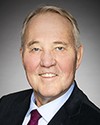I was.
Jack, I'll try to answer this briefly, and I don't mean to interrupt Minister Hajdu.
I would point out that there are 117 land points of entry at which Canadians can currently cross when they're returning from the United States. In addition to returning non-essential travellers, more than 90% of the people who cross at those land border points of entry are truck drivers. They're essential workers; they are bringing essential supplies to and from Canada. It's a very small cohort—in most border locations, fewer than 5%—of the travellers who are coming to that border who are non-essential in nature.
I would also point out that although some of them these border crossings are located in fairly densely populated urban areas, the vast majority of them are quite remote. They are hundreds of kilometres, and in some cases several hundreds of kilometres, from any possibility of a hotel or even PHAC staff at these things.
We've implemented the measures that we believe are appropriate, necessary and effective, given the size of the cohort of people we're dealing with. More than 90% of the people arriving at the airport are non-essential travellers, while a significantly smaller proportion of people at land borders are non-essential. The measures we've put in place, we believe, are the right measures.
I would also point out that at the airports we've limited all international travel to four international airports. They're located in Montreal, Toronto, Calgary and Vancouver—clearly, large urban centres where hotels and PHAC staff are available to manage the measures that have been put in place there.





